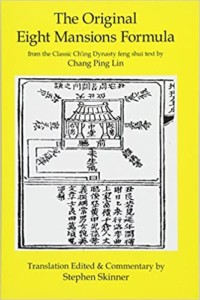 Modern-day Feng Shui practitioners are indebted to Dr. Stephen Skinner for writing some of the best books on our topic. In The Original Eight Mansions Formula he translates a classic text from 1739 by Chang Ping Lin and brings us an historical perspective to the practice of the Eight Mansions (East-West) School.
Modern-day Feng Shui practitioners are indebted to Dr. Stephen Skinner for writing some of the best books on our topic. In The Original Eight Mansions Formula he translates a classic text from 1739 by Chang Ping Lin and brings us an historical perspective to the practice of the Eight Mansions (East-West) School.
In modern times there are some misconceptions about the formulas, as well as unnecessary or questionable extrapolations to these same formulas. Skinner’s explanations are clear and the chart on page 23 alone is worth the price of the book.
Skinner answers right away a common question that many classical practitioners ask in regards to the seemingly contradictory information we get when combining the Eight Mansions method with the Flying Star School. Skinner explains how the two Schools can in fact be practiced together when one understands better their unique purposes. Most classically trained consultants have just been resigned to defend the Flying Star School as more “accurate” because it factors in time and smaller increments of space.
In the same way that we don’t think the plumbing system in your house contradicts the electrical system, they are separate domains and they don’t contradict each other when we understand that the Eight Mansion School is focused on doorways, pathways, and gates. The influences of the door opening, however, is not on the same wave length as the magnetic field created in spaces that are identified with the Flying Star School.
As an example, if we discover that an entrance is good based on the Eight Mansions School, passing through it will allow us to benefit. That said, if the flying stars in that same area are not so timely or positive in their influence, then dwelling in that area is not advised without adjustments being made. So, there is a difference between walking through a space versus spending time there. One circumstance may not cancel the other out.
A common misconception which has built in momentum over the last 25+ years is the extrapolation of good and bad directions being micro-managed within internal rooms, including internal doors to bedrooms or offices from internal hallways (based on the same Eight Mansions School). We can certainly see the small tai qi within the big tai qi in many examples, but this was apparently not the original concern of the Eight Mansions method.
Rather, the concern is with exterior doors, pathways and gates. This bit of insight alone also reconciles the hierarchy of how we view main entrances and lobbies for larger multi-family residential or commercial buildings. It is also a personal relief to me because some of the micro-managing of space is also “crazy-making” even for the firm believer in Feng Shui. To illustrate with a specific example: For a house which sits East, a West sector entry door is not an ideal entrance. However, this does not mean that an internal west sector door inside the various rooms is a problem. It does not carry the same influence as the exterior door.
Another revelation in Skinner’s book is the use of 24 mountains (24 directions) for the Eight Mansions formula. More often than not, we find modern literature about the Eight Mansions School using only the eight basic directions as a reference (North, Northeast, East, Southeast, South, Southwest, West, Northwest), as the very name of the School implies.
However, even within the Eight Mansions School, the house can be identified as sitting in one of 24 directions (3 subdivisions of the basic eight) and the auspicious doorway or gate openings can be found in one of the 24 directions as well.
In some cases we do have the entire basic direction to work with, such as the 45-degree span of East. But in another instance we may be addressing East-1, East-2, or East-3. These are all 15-degree increments of the whole East sector.
What is also included in the book is the description of pathways passing through more than one direction before arriving at the door. While we may see plenty of straight pathways (coming from one defined direction) like a straight bee-line toward a door, we may also see in more spacious and creative landscapes a meandering or curving path, which passes through several directions before arriving at its destination. The qi then manifests in more than one way.
For example, if we have a meandering path starting from the southeast corner of a lot and winding its way through the south and ultimately over to a west door, the influence can be combined from the southeast, south, southwest and finally to the west. Then, when making predictions about what kind of influence it will have on occupants, we can see the influence of various directions. In one example, if the pathway for a certain house type spans through the south (very bright yang energy) it is no surprise that the occupant may include someone of notoriety or accomplishment.
Author: Kartar Diamond
Company: Feng Shui Solutions ®
From the Feng Shui Theory Blog Series

